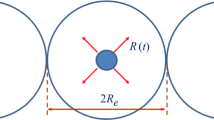Abstract
We consider a cylindrical crystal growing from the melt at a constant speed with a convex interface. Impurities from the melt segregate at the interface, and their approximate distribution in the solid is calculated in a dimensionless system with the following assumptions: a) the process occurs in the steady state; b) the impurities do not diffuse within the solid; c) the segregation at the interface is large. The determining parameter is the product of growth velocity and average curvature of the interface. When this parameter is large, the impurity concentration near the cylinder mantle is many orders of magnitude higher than near its axis. This gives rise to aradial refining process, which can be applied when diffusion in the liquid is low and convection has to be prevented. The problem is discussed for different shapes of the interface.
Résumé
Un crystal cylindrique croît dans la phase liquide à une vitesse constante avec une interface convexe. Les impuretés du liquide sont rejetées à l'interface, et leur distribution approximative dans le solide est calculée dans un système sans dimension à partir des hypothèses suivantes: a) le processus est à l'état stationnaire; b) les impuretés ne diffusent pas à l'intérieur du solide; c) la ségrégation à l'interface est suffisamment grande. Le paramètre déterminant est le produit de la vitesse de croissance et de la courbure moyenne de l'interface. Lorsqu'il est grand, la concentration des impuretés sur le manteau du cylindre dépasse de plusieurs ordres de grandeur celle du voisinage de l'axe. Ceci permet unprocédé radial de purification qui peut être appliqué lorsque la diffusion dans le liquide est faible et que la convection doit être évitée. Le problème est discuté pour différentes formes de l'interface.
Zusammenfassung
Ein zylindrischer Kristall wächst in der Schmelze mit einer konstanten Geschwindigkeit und besitzt eine konvexe Wachstumsfläche. Verunreinigungen der Schmelze werden an der Grenzfläche zurückgestoßen und ihre angenäherte Verteilung in der festen Phase wird unter den folgenden Voraussetzungen berechnet: a) der Vorgang befindet sich im stationären Zustand; b) die Verunreinigungen diffundieren nicht innerhalb der festen Phase; c) die Segregation an der Oberfläche ist genügend groß. Der bestimmende Parameter ist das Produkt der Wachstumsgeschwindigkeit und der mittleren Krümmung der Wachstumsfläche. Wenn er groß ist, ist die Verunreinigungskonzentration am Zylindermantel um viele Größenordnungen höher als bei seiner Achse. Dies ermöglicht einradiales Reinigungsverfahren, das angewandt werden kann, wenn die Diffusion in der Schmelze klein ist, und wenn keine Konvektion stattfindet. Das Problem wird mit verschiedenen Formen der Wachstumsfläche untersucht.
Similar content being viewed by others
References
Pfann, W. G.: Zone melting, New York: Wiley 1958.
Jaccard, C., etL. Levi: Ségrégation d'impuretés dans la glace, Helv. Phys. Acta12, Fasc.1, 70–76 (1961).
Tiller, W. A., andR. F. Sekerka: Redistribution of solute during phase transformation. J. appl. Phys.35, 2726–2729 (1964).
Blicks, H., H. Egger u.N. Riehl: Zur Verteilung von Fremdsubstanzen in Eis-Einkristallen. Phys. kondens. Materie2, 419–422 (1964).
Jaccard, C.: to be published.
Author information
Authors and Affiliations
Rights and permissions
About this article
Cite this article
Jaccard, C. Solute segregation at the curved surface of a growing crystal (steady state). Phys kondens Materie 4, 349–354 (1966). https://doi.org/10.1007/BF02422753
Received:
Issue Date:
DOI: https://doi.org/10.1007/BF02422753




